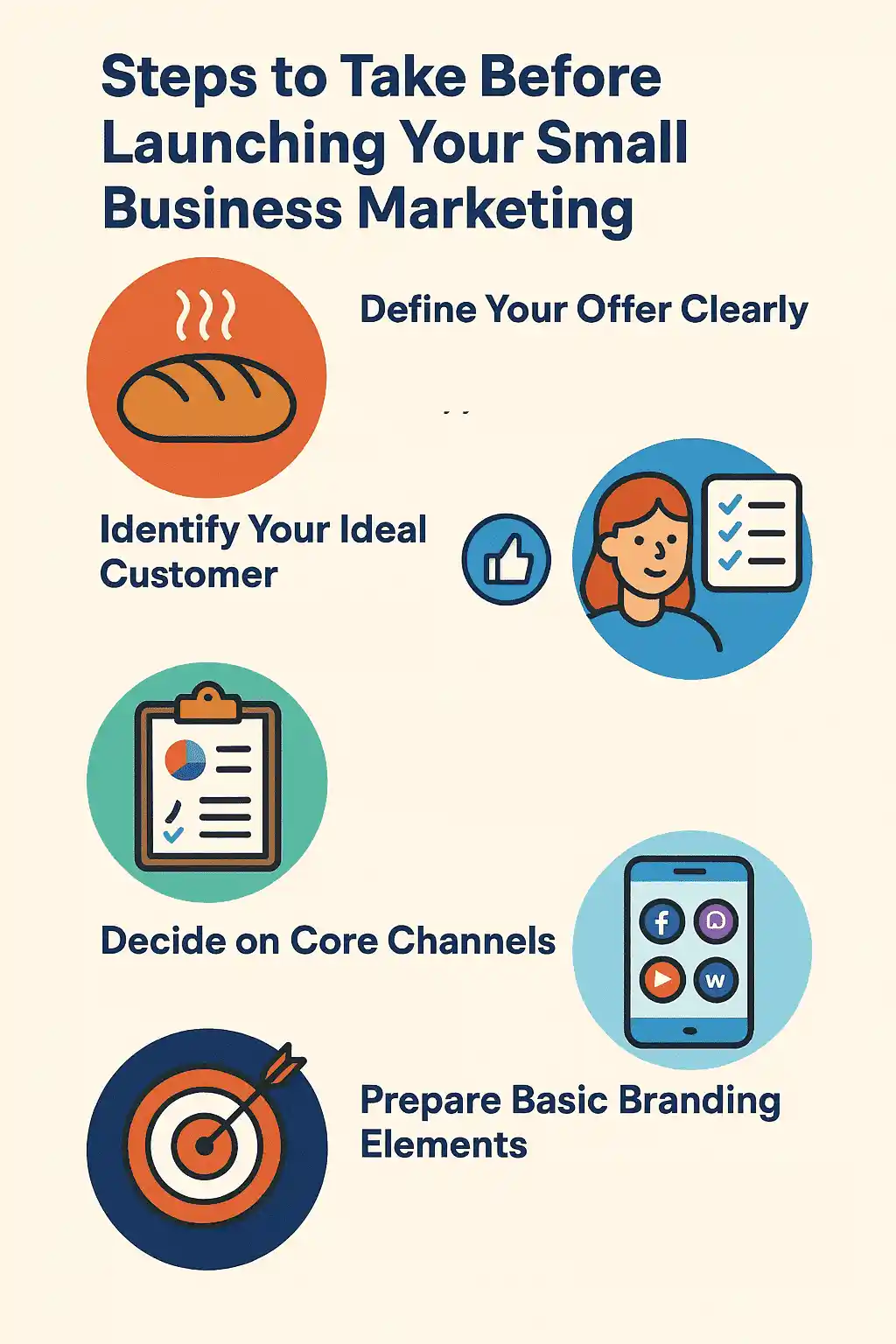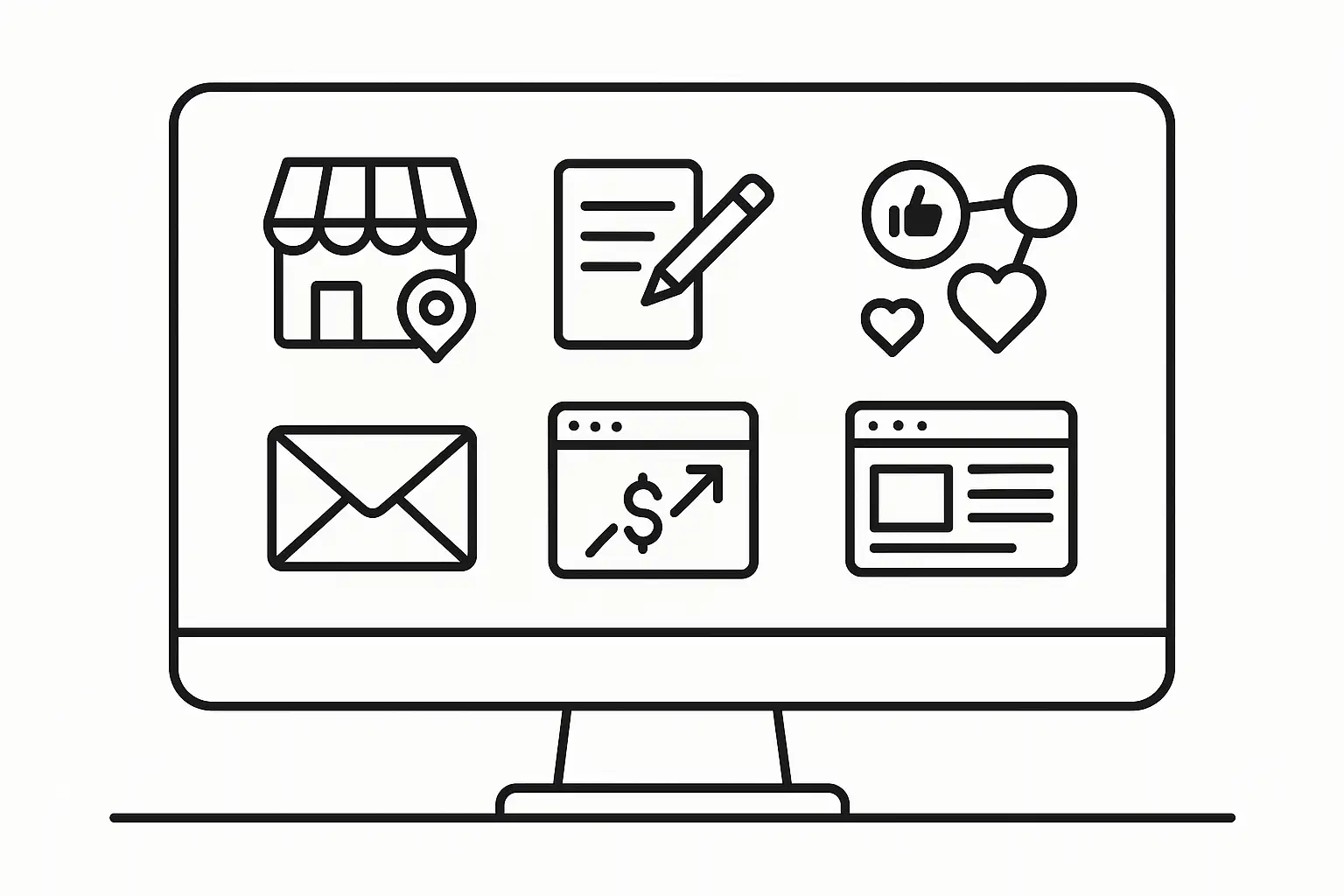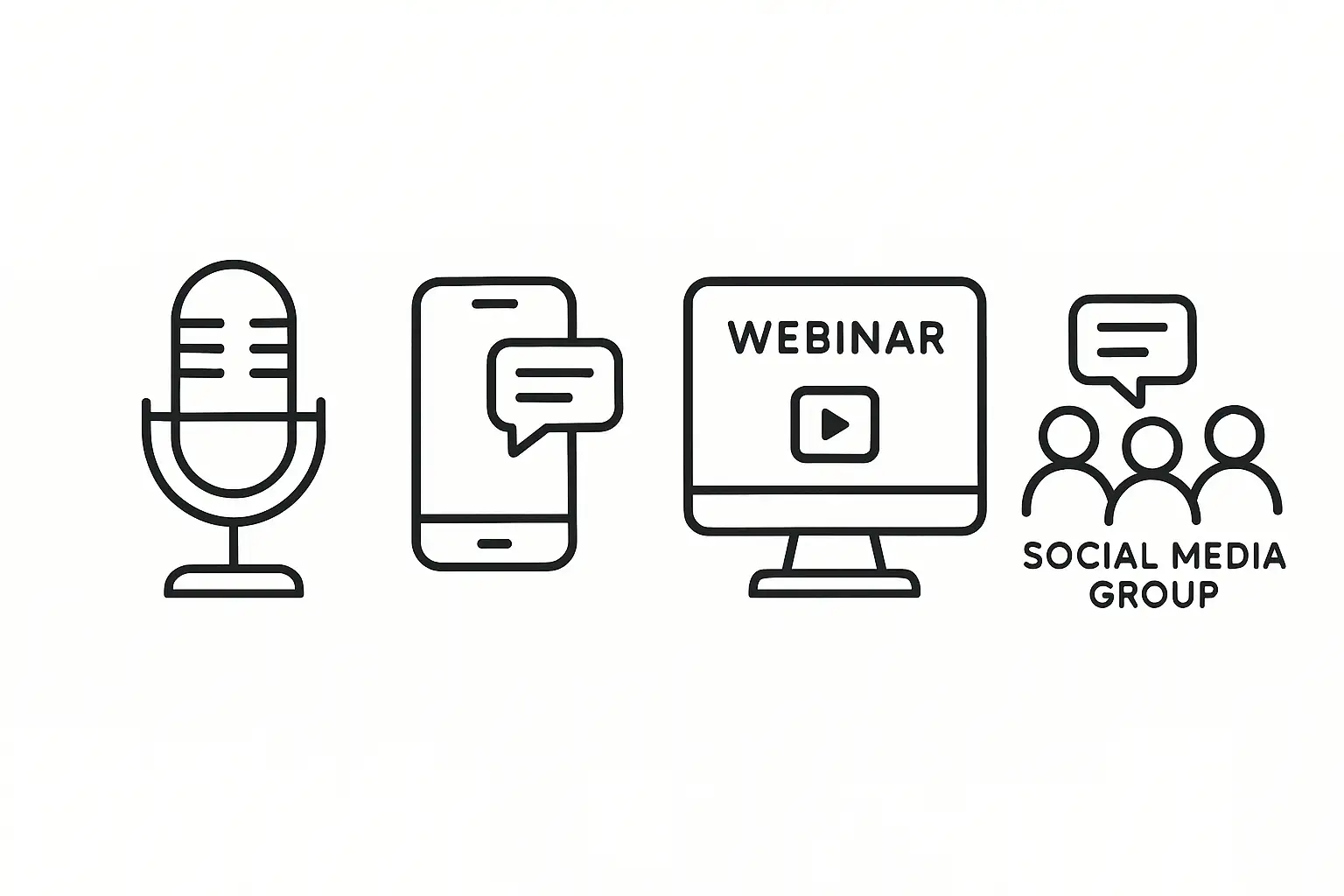Marketing a small business isn’t about copying what big companies do on a smaller scale. It’s about using what you have — time, budget, skills — in a way that actually gets attention and earns trust.
This article breaks down marketing ideas for small businesses that are direct, manageable, and grounded in what actually works. No vague promises. These are just steps and tools you can use based on your current stage, whether you’re starting out or adjusting after months of trial and error. Mehrana, as one of the best SEO companies Markham has to offer, focuses on practical strategies that help small businesses grow without the noise.
“Marketing is no longer about the stuff that you make, but about the stories you tell.”
What is Small Business Marketing?
Small business marketing means drawing in customers without the safety net of a big budget or large team. It relies on simple tools, clear messaging, and doing a few things well rather than spreading efforts too thin.
For many, this includes focused digital marketing efforts — like maintaining a clear presence online and using content to attract people who are already looking for answers. These activities don’t require large spending, but they do require consistency and a sense of what matters to the target audience.
Instead of paying for exposure at scale, small business owners often rely on tactics that are direct and measurable — like writing useful content, showing up in local search results, staying visible on the social platforms their buyers actually use, and sending emails that don’t feel like spam.
SEO also plays a role here. Appearing in relevant search results can drive traffic without paid ads, especially when the website answers specific questions that potential customers are searching for. It’s not about tricks — it’s about being visible where it counts.

Steps to Take Before Launching Your Small Business Marketing
Skipping groundwork in the early stages of marketing leads to poor decisions and wasted money. These six steps help prevent that by clarifying direction, narrowing your efforts, and reducing risk.

1. Define Your Offer Clearly
Start by writing out exactly what you sell — not just the item or service, but the outcome it creates for the buyer. For example, a bakery isn’t just selling bread; it’s selling freshness, convenience, or even a morning routine. Use this clarity to shape your messaging and pricing later.
2. Identify Your Ideal Customer
Create a simple customer profile: age range, job type, daily habits, income bracket, purchase behavior, and online habits. This isn’t theory — use real-world cues. Look at who already buys from you (if applicable) or who buys from similar businesses. The goal is to avoid marketing to “everyone” and instead reach the people most likely to care and buy.
3. Analyze Competitors
List 3–5 businesses offering something similar. Study their websites, ads, social content, and pricing. Look for patterns: Are they highlighting speed, quality, affordability, or something else? Then, identify where they might be weak: slow customer service, unclear branding, or neglected platforms. These gaps can be opportunities for you.
4. Set Realistic Goals
Pick short-term goals that reflect your available time and budget. Avoid vague aims like “get more exposure.” Instead, focus on things like:
- Get 100 email subscribers in 3 months
- Drive 200 visits to your site from organic search
- Book 20 intro calls per month
- Start small. Hit one goal before adding more.
5. Decide on Core Channels
You don’t need to be active on every platform. If your audience is local, consider Google Business Profile, local SEO, and print flyers. If they’re online shoppers, focus on Instagram, Pinterest, or paid search. Choose 2–3 core platforms that match where your customers already spend time, not where other brands happen to be active.
6. Prepare Basic Branding Elements
You don’t need a full branding agency to begin. Use a free logo maker, pick two easy-to-read fonts, and stick to 2–3 color shades that work across backgrounds. Make sure your name, contact info, and message are clear and consistent on every channel — website, social, packaging, etc. This consistency avoids confusion and builds recognition over time.
25 Top Marketing Strategies for Small Businesses
Marketing for a small business isn’t about doing everything. It’s about doing the right things consistently. These ten strategies work because they rely on clear communication, steady action, and accessible tools—even for one-person teams.
Each tactic below focuses on function over flash. You don’t need a big budget, but you do need to be direct, organized, and willing to test what works in your niche.
Digital Marketing Tactics Small Businesses

1.Set Up Google Business Profile
A well-maintained Google Business Profile helps people find your business when they search nearby. Add basic details like hours, address, and phone number. Use the right business categories. Upload photos that actually show what customers can expect—inside and out. Respond to reviews and keep the listing updated whenever something changes.
2. Optimize for Local SEO
Nearly all customers (+99%) check online for information about local businesses before visiting one in person. That makes local SEO more than a checklist item.
To stay visible:
- Keep your business name, address, and phone number consistent across platforms
- Use keywords that reflect your location and services
- Add a Google Map to your contact page
- Include location-based content where it fits naturally
- Link to and from other local websites
3. Create and Maintain a Blog
A blog isn’t just filler—it’s a way to answer questions your customers actually ask. Write about real problems or needs that relate to your services. Use everyday language. Include links to other pages on your site when it helps the reader. Once a post is outdated, either update it or remove it. Let the blog reflect what you currently offer and know.
4. Use Social Media Consistently
Roughly 5 billion people use social media worldwide. What is the average time spent per day? Over 2 hours. That’s a lot of chances to be seen.
How to stay consistent:
- Post regularly, even if it’s just twice a week
- Show actual people or places tied to your business
- Mix in useful tips, updates, or local shout-outs
- Use tools like Buffer or Meta Business Suite to schedule in advance
- Check comments and DMs—reply when someone takes the time to reach out
5. Start Email Marketing
Email still works. It reaches people directly and doesn’t depend on algorithms. Use it to send news, updates, or offers to people who actually want to hear from you. Build your list through your site or in person. Don’t buy lists—bad open rates and even worse trust. Segmenting can help, but even basic lists work if the content is worth reading.
6. Run Online Ads (Google Ads, Meta, etc.)
Google Ads work well when people are already searching. Meta platforms (Facebook, Instagram) are better when you’re trying to be seen. The average small business spends about $9,000–$10,000 a month on Google Ads, but many start smaller and ramp up.
Basic tips:
- Start with one campaign and one audience
- Match ads to relevant landing pages
- Use clear, short copy and one call-to-action
- Review results weekly and pause anything underperforming
7. Build or Improve Your Website
People decide quickly if they want to stay on a website. If it loads slowly or looks off on mobile, most will leave within seconds. Navigation should be obvious. Phone numbers and contact options should be easy to find. If a visitor doesn’t know what to do next, the design isn’t helping. Track what users do on your site with tools like Google Analytics and adjust from there.
8. Encourage Customer Reviews on Key Platforms
Reviews influence decisions. In 2023, 87% of consumers said they read online reviews for local businesses, and more than half won’t consider one with fewer than 4 stars.
Make it easier for people to leave reviews:
- Send links via text or email after the service
- Mention it during in-person visits
- Reply to reviews so people know you’re paying attention
- Don’t overthink it—just be consistent about asking
9. Use Video Marketing (YouTube, Reels, TikTok)
You don’t need expensive equipment to make helpful videos. A phone and good lighting are often enough. Use short clips to explain your services, answer FAQs, or show how something works. YouTube helps with search, while TikTok and Reels are better for short content with a wide reach. Subtitles matter—many watch with sound off.
10.List Your Business in Online Directories
Some people still use platforms like Yelp, Bing Places, or even Yellow Pages to look up businesses. Being listed correctly helps search engines connect the dots.
Important directories to consider:
- Google Business Profile
- Yelp
- Bing Places
- Apple Maps
- Industry-specific directories (e.g., Avvo, Healthgrades)
- Local business groups or chambers of commerce
Double-check that your contact info is consistent everywhere. One mismatch can cause confusion for users and search engines.
Offline or In-Person Strategies

11.Attend Local Events and Networking Meetups
Meeting people in person still carries weight. It creates context that email or ads can’t. Local business mixers, city-run events, or niche meetups are solid places to start. Bring simple printouts or cards—something they can hold onto. Don’t oversell. Just introduce yourself, have a real conversation, and follow up the next day while you’re still fresh in their mind.
12.Launch a Referral Program
Word-of-mouth still beats most marketing channels. In fact, 92% of consumers trust personal recommendations more than any ad.
To build something that works:
- Offer a clear incentive—free item, small discount, or store credit
- Make it low-effort for people to refer someone
- Promote it on receipts, checkout counters, or after appointments
- Track it on paper if needed—don’t wait to automate
13.Collaborate with Nearby Businesses
You don’t need formal partnerships or contracts to work with your neighbors. Look around—any business with a similar customer base could be a fit. A café could share space for a pop-up shop. A fitness studio might recommend a nearby physical therapist. These arrangements cost little, but the reach can grow fast.
14.Sponsor a Local Event or Organization
Even small-scale sponsorships make your business visible to new people. According to Eventbrite, 63% of event attendees say they’re more likely to consider a business they saw involved in something they care about.
Start small:
- Youth sports teams
- Community clean-up days
- Holiday parades or block parties
- Local school events or fundraisers
You don’t always need a booth or banner. Sometimes, a name on a shirt or a flyer insert is enough.
15.Use Direct Mail (Flyers, Postcards, Catalogs)
It’s easy to skip over emails or ads. A postcard, on the other hand, is held—read—or at least glanced at. Keep the message short. One offer, one contact method, and a visual that fits your brand.
Best times to send:
- During seasonal shifts
- Before a holiday
- When launching something new
- To re-engage old customers
16.Set Up Loyalty or Rewards Programs
Returning customers don’t need much convincing. They already trust you. A punch card or points system can give them a reason to come back a little sooner.
Data from Accenture shows that 57% of people spend more with brands they regularly return to.
How to keep it simple:
- Offer a freebie after a set number of visits
- Use tools like Square Loyalty or stick with paper cards
- Mention it clearly at checkout
- Reward frequency, not just spend
17.Explore Local Outdoor Advertising
Local signage can still work when placed well. Think benches, bus stops, or small billboards near your business or high-traffic streets. It needs to be easy to read in seconds.
Stick to:
- A short headline
- Your name or service
- A phone number or short URL
Some businesses use a separate phone number just for these ads to measure calls, but that’s optional. If you can’t track results directly, ask new customers how they heard about you.
Creative and Hybrid Ideas

18.Host a Free Webinar or Workshop
Running a workshop—even a short one—can help demonstrate what you know while giving potential customers a reason to pay attention. Choose one clear topic that solves a small, specific problem. Keep it to 30–45 minutes. Include a Q&A if you’re live.
For in-person events, keep the group small so there’s time to interact. Use Eventbrite, Zoom, or Google Meet for online sessions. Promote through your email list, social accounts, or flyers if it’s local.
19.Launch a Niche Business Podcast
Podcasts can work well if your business serves a specific group. Even a small, loyal listener base can be useful. According to Edison Research, 64% of people in the U.S. over age 12 have listened to a podcast, and weekly listeners average nine episodes per week.
To keep it manageable:
- Stick to short episodes (10–20 minutes)
- Use free tools like Spotify for Podcasters or Anchor
- Pick a topic that ties into your business but isn’t only about it
- Use guests to add variety and reach new audiences
20.Try SMS/Text Message Marketing
Texting can be direct and effective—if done right. The open rate for SMS is often above 90%, especially for local offers or last-minute updates. Don’t overdo it. A couple of messages a month is plenty unless people specifically ask for more.
Some common uses:
- Time-sensitive deals
- Appointment reminders
- Quick polls or feedback
- Links to events, coupons, or product drops
Use a system like Twilio, SimpleTexting, or your POS if it has built-in SMS tools.
21.Start a Facebook or WhatsApp Group
Groups give people a way to interact around your business without making it all about sales. This works best for service-based businesses, interest-based brands, or anything community-driven.
Post regularly to keep it active—conversations dry up fast without a nudge. Share tips, ask questions, highlight customer stories, or post behind-the-scenes updates. Keep the tone natural. If it feels like a feed of ads, people won’t stick around.
22.Run Customer Feedback Surveys
Getting honest feedback doesn’t need to be complicated. Short surveys—3 to 5 questions—get more responses than long ones. Use Google Forms, Typeform, or even a QR code printed on receipts. You can ask what brought them in, what they’d change, or how likely they are to return.
In one SurveyMonkey report, 85% of customers said they’d give feedback if they knew it would lead to real improvements.
Use what you learn. Don’t just collect responses—act on them.
23.Offer Seasonal Promotions or Limited-Time Discounts
Timing matters. Discounts tied to holidays, weather shifts, or local events often feel more relevant—and more urgent. Instead of offering year-round deals, rotate them by month or season.
Examples:
- January: “New Year” service bundles
- Spring: Home or garden prep packages
- Summer: Event-driven flash sales
- December: Gift-card bonuses or multi-purchase discounts
24.Partner with Local Influencers
Micro-influencers (those with 1,000–10,000 followers) can be surprisingly effective, especially when they’re already known in your area. Big reach isn’t the goal—relevance is. You want people who are local, trusted, and aligned with your audience.
Some options:
- Offer free products or services in exchange for a post
- Co-host an event or giveaway
- Share their content and tag them
- Pay for a short review or unboxing, but keep it authentic
Make sure the messaging is natural. Overly scripted posts tend to fall flat.
25.Run Contests or Giveaways on Social Media
Giveaways still attract attention—if the prize makes sense for your audience. Keep the entry rules short and easy to follow. Ask people to comment, share, or tag a friend. Stick to platforms where you’re already active.
A Tailwind study found that Instagram contests get 3.5x more likes and 64x more comments on average than regular posts.
Tips for running a clean contest:
- Choose a prize connected to your actual business
- Avoid overly generic prizes (like gift cards to national chains)
- Run it for 3–7 days max
- Announce the winner publicly and follow up directly
Is Outsourcing Marketing Right for Your Small Business?
Handling all your marketing in-house might seem like the most affordable option, especially early on. However, time, skill gaps, and inconsistent execution often limit results. That’s when outsourcing becomes worth considering.
When It Makes Sense:
- You don’t have time to plan or post consistently
Marketing only works when done regularly. If your schedule doesn’t allow that, results will stall. A freelancer or agency can fill the gap without being managed daily.
- You lack specific skills
Writing copy, managing ad platforms, creating visuals, or setting up SEO — these aren’t things you can always figure out on the fly. If you’re spending hours trying to learn something and still not getting results, it’s time to delegate.
- You’re running campaigns that require technical setup
Things like Google Ads, Facebook pixel tracking, email automation, and website optimization usually need someone who knows what they’re doing. One misstep can waste your budget or break your funnel.
What to Outsource First:
- Website design or updates
- SEO setup and keyword research
- Paid ad management
- Email marketing campaigns
- Blog writing or content strategy
What to Keep In-House (if possible):
- Customer interactions (DMs, replies, calls)
- Product or service knowledge
- Local partnerships and relationships
If you decide to outsource, don’t just look at price. Ask for examples, check how they communicate, and start with a short-term project before locking into any long-term deal.
Best Resources and Tools for Small Business Marketing
You don’t need dozens of tools — just a few that save time and help you make better decisions. These options are widely used, free or low-cost, and beginner-friendly:
Content and SEO
- WordPress or Wix – Simple site builders with blogging features
- Yoast SEO (for WordPress) – Helps with on-page SEO
- Ubersuggest – Keyword research and site analysis
Email Marketing
- Brevo (formerly Sendinblue) – Easy automation and list segmentation
- MailerLite – Clean interface with strong free tier
Analytics
- Google Analytics – Tracks site traffic, sources, and behavior
- Google Search Console – Shows keyword data and search performance
Design and Content
- Canva – Templates for posts, flyers, and email graphics
- CapCut – Video editing on desktop or mobile
Social Media
- Buffer or Later – Schedule and manage posts across platforms
- Meta Business Suite – For managing Facebook and Instagram together
Stick to 3–5 core tools. Add more only when there’s a clear need.
Conclusion
Small business marketing doesn’t require large budgets — just clear goals, useful content, and a system that fits your time and skills. Start with a simple, functional website, write content that answers real questions, and stick to a couple of channels where your target customers already spend time.
Measure results regularly using free tools and adjust based on what’s working, not just what looks good. If your time is limited, consider outsourcing specific tasks rather than trying to handle everything alone.
The most reliable growth happens when your marketing matches what your customers actually want to see, read, or hear, not what other brands are doing. Stay consistent, keep it simple, and build from there.
FAQ
2000-3000 words tend to perform well, but relevance and structure matter more than length.
Once a week is a good rhythm to stay visible without overwhelming subscribers.
Only if your site is ready (mobile-friendly, clear CTA) and you know your audience well. Otherwise, you risk wasting money.
Depends on intent. Use Google Ads for high-buying-intent searches; Facebook for discovery and retargeting.
Use UTM links in emails and track actions (like purchases or sign-ups) in Google Analytics or your email platform’s dashboard.







